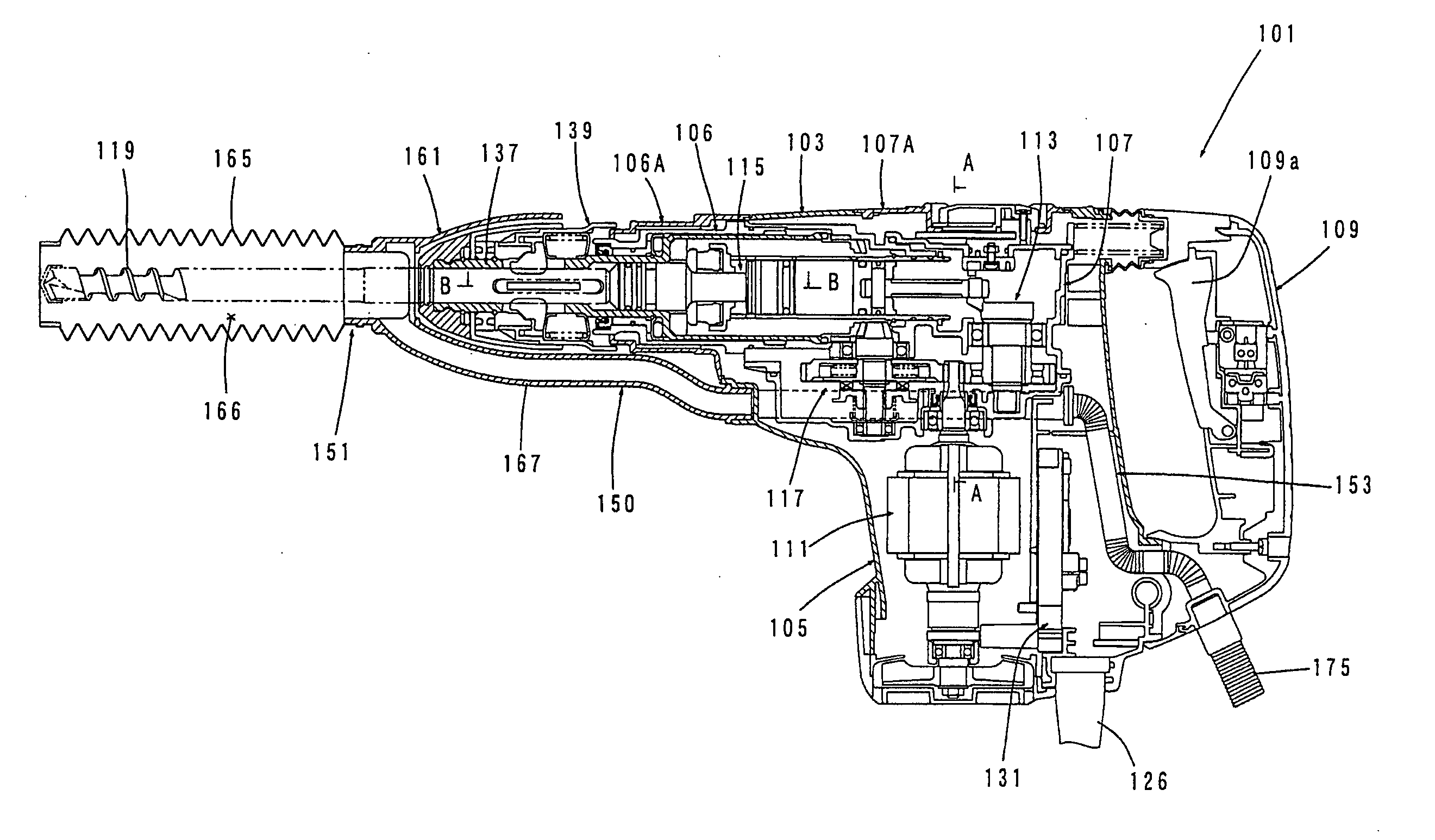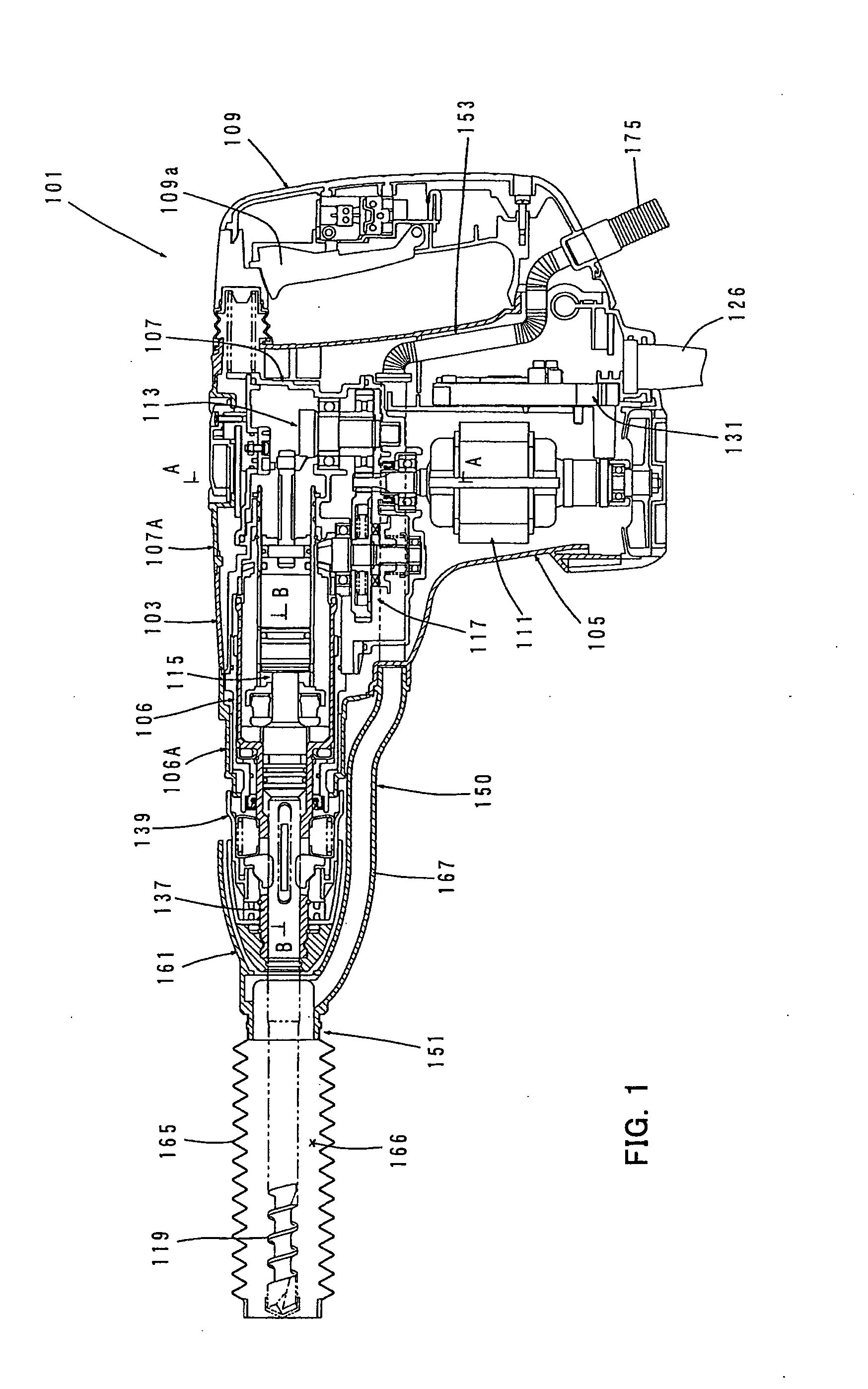Power tool
a technology of power tools and dust collection, which is applied in the field of dust collection techniques of power tools, can solve problems such as the inability to operate the power tools, and achieve the effects of reducing the amount of dust entering the carbon brush, reducing the cost of repair, and facilitating the replacement of the tool bi
- Summary
- Abstract
- Description
- Claims
- Application Information
AI Technical Summary
Benefits of technology
Problems solved by technology
Method used
Image
Examples
first representative embodiment
[0043]A first representative embodiment of the invention is now described with reference to FIGS. 1 to 6. In the first embodiment, an electric hammer drill is explained as a representative example of a power tool according to the invention. FIGS. 1 and 2 mainly show an entire electric hammer drill 101. FIG. 2 shows the state in which a dust suction unit 151 is not yet attached to the hammer drill 101. FIGS. 3 and 4 are partially enlarged sectional views of FIG. 1. FIG. 5 is a sectional view taken along line A-A in FIG. 1 and FIG. 6 is a sectional view taken along line B-B in FIG. 1.
[0044]As shown in FIGS. 1 to 4, the representative hammer drill 101 includes a body 103 that forms an outer shell of the hammer drill 101, a hammer bit 119 detachably coupled to a tip end region (left end as viewed in FIG. 1) of the body 103 via a tool holder 137, and a handgrip 109 designed to be held by a user and connected to the body 103 on the side opposite to the hammer bit 119. The body 103, the ha...
second representative embodiment
[0070]A second representative embodiment of the invention is now described with reference to FIGS. 7 to 10. In the second embodiment, in addition to the handgrip 109, a side grip 181 is mounted to the body 103 of the hammer drill 101. In the other points, it has the same construction as the above-described first embodiment. Therefore, components and elements which are substantially identical to those in the first embodiment are given like numerals and are not described or only briefly described. The side grip 181 is a feature that corresponds to the “side handle” according to this invention.
[0071]The side grip 144 is a rod-like member that extends horizontally in a direction transverse to the axial direction of the hammer bit 119 and mainly includes a grip body 182 that is detachably mounted to the barrel cover 106A and a grip part 183 to be held by a user. The grip part 183 is formed by a hollow cylindrical member connected at one longitudinal end to the grip body 182. A grip mount...
third representative embodiment
[0077]A third representative embodiment of the invention is now described with reference to FIGS. 11 to 19. In this embodiment, as shown in FIGS. 11 to 15, a plurality of suction holes 172 are formed in the dust transfer passage 153 disposed within the body 103 in the hammer drill 101 and serve to provide communication between the inside of the dust transfer passage 153 and the space S of the body 103 (space between the inner housing and the outer housing) such that heat within the body 103 and dust which enters the body 103 are allowed to escape to the outside through the suction holes 172.
[0078]Specifically, in the pipe 171 which is disposed in the space S formed between the inner wall surface of the motor housing 105 and the outer wall surface of the lower region of the gear housing 107 covered by the motor housing 105, the suction holes 172 are formed to provide communication between the inside of the pipe 171 and the space S, so that heat generated within the body 103 and dust ...
PUM
| Property | Measurement | Unit |
|---|---|---|
| power | aaaaa | aaaaa |
| flexible | aaaaa | aaaaa |
| shape | aaaaa | aaaaa |
Abstract
Description
Claims
Application Information
 Login to View More
Login to View More - R&D
- Intellectual Property
- Life Sciences
- Materials
- Tech Scout
- Unparalleled Data Quality
- Higher Quality Content
- 60% Fewer Hallucinations
Browse by: Latest US Patents, China's latest patents, Technical Efficacy Thesaurus, Application Domain, Technology Topic, Popular Technical Reports.
© 2025 PatSnap. All rights reserved.Legal|Privacy policy|Modern Slavery Act Transparency Statement|Sitemap|About US| Contact US: help@patsnap.com



